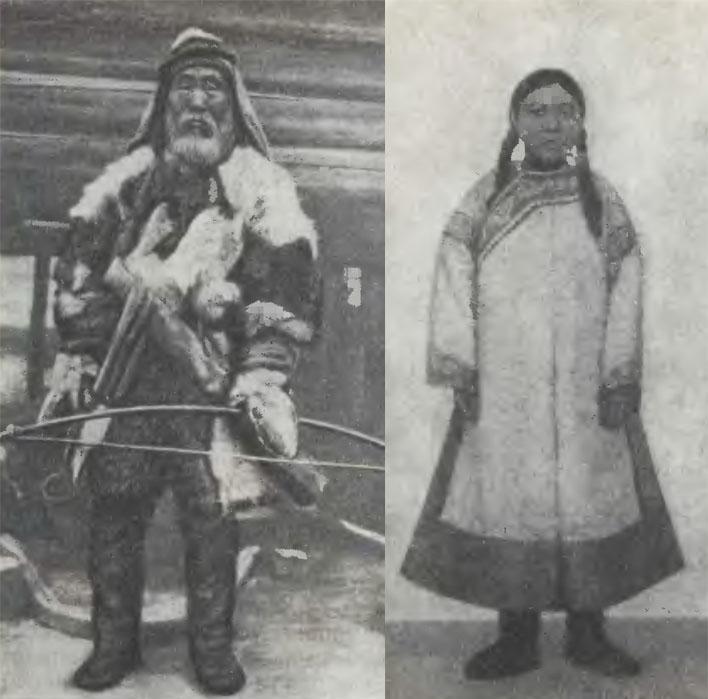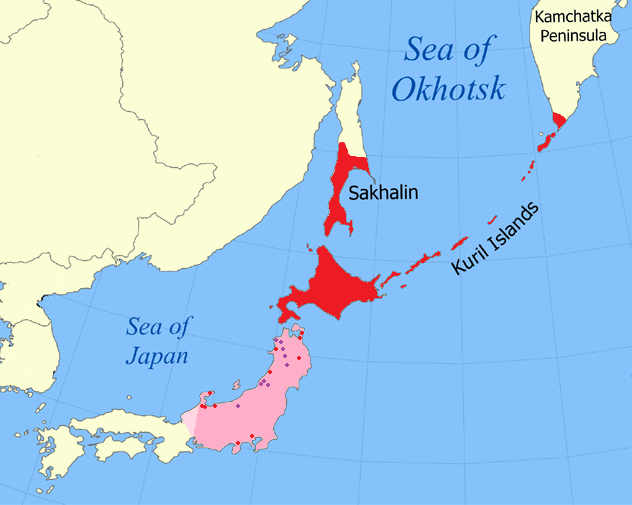|
Ulch People
The Ulch people, also known as Ulch or Ulchi, (russian: ульчи, obsolete ольчи; Ulch: , nani) are an indigenous people of the Russian Far East, who speak a Tungusic language known as Ulch. Over 90% of Ulchis live in Ulchsky District of Khabarovsk Krai, Russia. According to the 2002 Census, there were 2,913 Ulchs living in Russia — down from 3,173 recorded in the 1989 Census, but up from 2,494 recorded in the 1979 Census, and 2,410 recorded in the 1970 Census. According to the 2010 Census there were 2,765 Ulchs in Russia. History The Ulch people descend from the autochthonous Paleolithic population of coastal Northeast Asia and were found to be very similar to ancient samples found in this region from about 8000 years ago. The Ulch people are often classified as one of the ancient Paleosiberian peoples, which is however not an ethno-linguistic group but a term applied to various ethnic groups of Siberia which do not belong to the bigger Northeast Asian ... [...More Info...] [...Related Items...] OR: [Wikipedia] [Google] [Baidu] |
Ulch Language
The Ulch language, or ''Olcha'', is a Tungusic language spoken by the Ulch people in the Russian Far East. Phonology Vowels * Vowel length is also distributed. Consonants * is a rare sound in native words. * /β ɡ/ have allophones of ɣ * /k x/ can become uvularized as χbefore vowels /a o/.Sunik, 1985 Alphabet In brackets are letters that are used in writing, though not officially included in the alphabet. References Bibliography * *Sunik, O. P. (1985). Ul'chskij jazyk: issledovanija i materialy. Leningrad: Nauka, Leningradskoe Otdelenie. 262pp. External links * ELAR archive oEndangered Tungusic languages of Khabarovskij Kraj (including Ulcha) {{DEFAULTSORT:Ulch Language Agglutinative languages Critically endangered languages Languages of Russia Tungusic languages stub ... [...More Info...] [...Related Items...] OR: [Wikipedia] [Google] [Baidu] |
Russia
Russia (, , ), or the Russian Federation, is a transcontinental country spanning Eastern Europe and Northern Asia. It is the largest country in the world, with its internationally recognised territory covering , and encompassing one-eighth of Earth's inhabitable landmass. Russia extends across eleven time zones and shares land boundaries with fourteen countries, more than any other country but China. It is the world's ninth-most populous country and Europe's most populous country, with a population of 146 million people. The country's capital and largest city is Moscow, the largest city entirely within Europe. Saint Petersburg is Russia's cultural centre and second-largest city. Other major urban areas include Novosibirsk, Yekaterinburg, Nizhny Novgorod, and Kazan. The East Slavs emerged as a recognisable group in Europe between the 3rd and 8th centuries CE. Kievan Rus' arose as a state in the 9th century, and in 988, it adopted Orthodox Christianity from the ... [...More Info...] [...Related Items...] OR: [Wikipedia] [Google] [Baidu] |
Hokkaido
is Japan, Japan's Japanese archipelago, second largest island and comprises the largest and northernmost Prefectures of Japan, prefecture, making up its own List of regions of Japan, region. The Tsugaru Strait separates Hokkaidō from Honshu; the two islands are connected by the undersea railway Seikan Tunnel. The largest city on Hokkaidō is its capital, Sapporo, which is also its only Cities designated by government ordinance of Japan, ordinance-designated city. Sakhalin lies about 43 kilometers (26 mi) to the north of Hokkaidō, and to the east and northeast are the Kuril Islands, which are administered by Russia, though the four most southerly are Kuril Islands dispute, claimed by Japan. Hokkaidō was formerly known as ''Ezo'', ''Yezo'', ''Yeso'', or ''Yesso''.Louis Frédéric, Nussbaum, Louis-Frédéric. (2005). "Hokkaidō" in Although there were Japanese settlers who ruled the southern tip of the island since the 16th century, Hokkaido was considered foreign territo ... [...More Info...] [...Related Items...] OR: [Wikipedia] [Google] [Baidu] |
Strait Of Tatary
Strait of Tartary or Gulf of Tartary (russian: Татарский пролив; ; ja, 間宮海峡, Mamiya kaikyō, Mamiya Strait; ko, 타타르 해협) is a strait in the Pacific Ocean dividing the Russian island of Sakhalin from mainland Asia (South-East Russia), connecting the Sea of Okhotsk on the north with the Sea of Japan on the south. It is long, wide, and less than deep at its deepest point. History Yuan dynasty During the Yuan dynasty, the Yuan armies crossed the strait in the Mongol invasions of Sakhalin. Alleged remnants of a Chinese fort dating back to the Mongol Yuan era can be found in Sakhalin today. "Tartary" is an older name used by Europeans to refer to a vast region covering Inner Asia, Central Asia and North Asia. The toponym is derived from the Medieval ethnonym Tartars, which was applied to various Turkic and Mongol semi-nomadic empires, including the Yuan dynasty that ruled over China and the straits of Northeast Asia. Qing dynasty During th ... [...More Info...] [...Related Items...] OR: [Wikipedia] [Google] [Baidu] |
Amgun River
The Amgun () is a river in Khabarovsk Krai, Russia that flows northeast and joins the river Amur from the left, 146 km upstream from its outflow into sea. The length of the river is . The area of its basin is . The Amgun is formed by the confluence of the Ayakit and Suluk. Its main tributary is the Nimelen. The Amgun teems with fish, such as , , [...More Info...] [...Related Items...] OR: [Wikipedia] [Google] [Baidu] |
Sakhalin
Sakhalin ( rus, Сахали́н, r=Sakhalín, p=səxɐˈlʲin; ja, 樺太 ''Karafuto''; zh, c=, p=Kùyèdǎo, s=库页岛, t=庫頁島; Manchu: ᠰᠠᡥᠠᠯᡳᠶᠠᠨ, ''Sahaliyan''; Orok: Бугата на̄, ''Bugata nā''; Nivkh: Yh-mif) is the largest island of Russia. It is north of the Japanese archipelago, and is administered as part of the Sakhalin Oblast. Sakhalin is situated in the Pacific Ocean, sandwiched between the Sea of Okhotsk to the east and the Sea of Japan to the west. It is located just off Khabarovsk Krai, and is north of Hokkaido in Japan. The island has a population of roughly 500,000, the majority of which are Russians. The indigenous peoples of the island are the Ainu, Oroks, and Nivkhs, who are now present in very small numbers. The Island's name is derived from the Manchu word ''Sahaliyan'' (ᠰᠠᡥᠠᠯᡳᠶᠠᠨ). Sakhalin was once part of China during the Qing dynasty, although Chinese control was relaxed at times. Sakhalin ... [...More Info...] [...Related Items...] OR: [Wikipedia] [Google] [Baidu] |
Amur
The Amur (russian: река́ Аму́р, ), or Heilong Jiang (, "Black Dragon River", ), is the world's tenth longest river, forming the border between the Russian Far East and Northeastern China ( Inner Manchuria). The Amur proper is long, and has a drainage basin of . ''mizu'' ("water") in Japanese. The name "Amur" may have evolved from a root word for water, coupled with a size modifier for "Big Water". Its ancient Chinese names were ''Yushui'', ''Wanshui'' and ''Heishui'', formed from variants to ''shui'', meaning "water".The fishes of the Amur River:updated check-list and zoogeography'' The modern Chinese name for the river, ''Heilong Jiang'' means "Black Dragon River", while the Manchurian name ''Sahaliyan Ula'', the Mongolian names " Amar mörön " (Cyrillic: Амар мөрөн) originates from the name " Amar " meaning to rest and ''Khar mörön'' (Cyrillic: Хар мөрөн) mean Black River. Course The river rises in the hills in the western part of Northea ... [...More Info...] [...Related Items...] OR: [Wikipedia] [Google] [Baidu] |
Paleosiberian Peoples
Siberia, including the Russian Far East, is a vast region spanning the northern part of the Asian continent, and forming the Asiatic portion of Russia. As a result of the Russian conquest of Siberia (17th to 19th centuries) and of the subsequent population movements during the Soviet era (1917-1991), the modern-day demographics of Siberia is dominated by ethnic Russians ( Siberiaks) and other Slavs. However, there remains a slowly increasing number of indigenous groups, between them, accounting for about 10% of the total Siberian population (about 4,500,000), some of which are closely genetically related to indigenous peoples of the Americas. History In Kamchatka, the Itelmens' uprisings against Russian rule in 1706, 1731, and 1741, were crushed. During the first uprising the Itelmen were armed with only stone weapons, but in later uprisings they used gunpowder weapons. The Russian Cossacks faced tougher resistance from the Koryaks, who revolted with bows and guns from 1 ... [...More Info...] [...Related Items...] OR: [Wikipedia] [Google] [Baidu] |
Northeast Asia
Northeast Asia or Northeastern Asia is a geographical subregion of Asia; its northeastern landmass and islands are bounded by the Pacific Ocean. The term Northeast Asia was popularized during the 1930s by American historian and political scientist Robert Kerner. Under Kerner's definition, "Northeast Asia" included the Mongolian Plateau, the Northeast China Plain, the Korean Peninsula, the Japanese archipelago, and the mountainous regions of the Russian Far East, stretching from the Lena River in the west to the Pacific Ocean in the east. Definitions The definition of Northeast Asia is not static but often changes according to the context in which it is discussed. In common usage, the term Northeast Asia typically refers to a region which includes Northeast China (Inner Mongolia and Manchuria). Other countries and territories which make up Northeast Asia are the Russian Far East including the Sea of Okhotsk, Mongolia, Japan, North Korea, and South Korea. Parts or the whole ... [...More Info...] [...Related Items...] OR: [Wikipedia] [Google] [Baidu] |
Soviet Census (1970)
The Soviet Census conducted in January 1970 was the first census held in Soviet Union (USSR) in eleven years (since January 1959). Summary The Soviet population in 1970 was recorded as being 241,720,134 people, an increase of over 15% from the 208,826,650 people recorded in the Soviet Union in the 1959 Soviet census. While there was speculation that ethnic Russians would become a minority in the Soviet Union in 1970, the 1970 census recorded 53% (a bare majority) of the Soviet population as being ethnic Russians. In terms of total numbers, there were 129,015,140 ethnic Russians in the Soviet Union in 1970. Meanwhile, the largest ethnic minorities in the Soviet Union in 1970 were Ukrainians (40,753,246 in total), Uzbeks (9,195,093 in total), Belarusians (9,051,755 in total), Tatars (5,783,111 in total), Kazakhs The Kazakhs (also spelled Qazaqs; Kazakh: , , , , , ; the English name is transliterated from Russian; russian: казахи) are a Turkic-speaking ethnic group ... [...More Info...] [...Related Items...] OR: [Wikipedia] [Google] [Baidu] |





